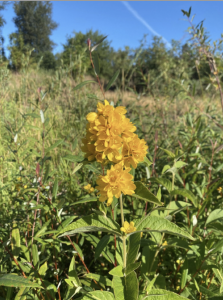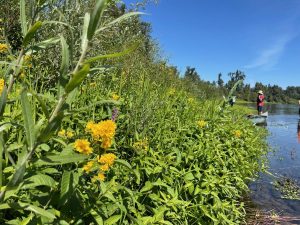Article reprinted with permission from Willamette Riverkeeper‘s October newsletter.
 This summer Willamette Riverkeeper’s restoration team joined forces with Yamhill Soil and Water Conservation District to manage their Oregon State Weed Board grant which focused on an early detection rapid response (EDRR) aquatic invasive species that many people aren’t quite familiar with: Lysimachia vulgaris, common name garden loosestrife. This species is an Oregon Department of Agriculture (ODA) ‘A’ listed EDRR weed from Eurasia that was brought over as an ornamental plant. ODA was alerted to its presence by an anonymous river recreationist who reported it to the invasive hotline in 2016. Citizen science really works! They investigated the location of this sighting and once it was confirmed as garden loosestrife, ODA treated the patch which was found at the tip of Wheatland Bar in Yamhill County. As of last year, there were only 8 known populations of this species.
This summer Willamette Riverkeeper’s restoration team joined forces with Yamhill Soil and Water Conservation District to manage their Oregon State Weed Board grant which focused on an early detection rapid response (EDRR) aquatic invasive species that many people aren’t quite familiar with: Lysimachia vulgaris, common name garden loosestrife. This species is an Oregon Department of Agriculture (ODA) ‘A’ listed EDRR weed from Eurasia that was brought over as an ornamental plant. ODA was alerted to its presence by an anonymous river recreationist who reported it to the invasive hotline in 2016. Citizen science really works! They investigated the location of this sighting and once it was confirmed as garden loosestrife, ODA treated the patch which was found at the tip of Wheatland Bar in Yamhill County. As of last year, there were only 8 known populations of this species.
Our team completed three survey days on July 27th, 28th, and August 29th, covering from Keizer Rapids Park to San Salvador Beach. These surveys consisted of multiple canoes, with boats on both sides of the river, and trained eyes scanning the banks for sightings of this species. Due to the prolonged high-water levels this spring, we all saw a delay in plant development which made this expedition a little more challenging. Our first two days, this species did not yet have it’s beautiful and bright yellow orangish flowers, so our team was identifying solely by the vegetation. Garden loosestrife has leaf shapes ranging from ovate (egg shaped) to lanceolate (longer than wide, pointed tip), and can range from 3-5 inches in length. The arrangement is opposite to whorled with 3-5 leaves and are attached directly to the stem (sessile). When this species is not in flower, the stems are the best way to set them apart from purple loosestrife, Lythrum salicaria which is another listed invasive, but is ‘B’ listed species meaning it is sadly regionally abundant. Garden loosestrife has rounder stems which are often hairy or fuzzy versus purple loosestrife’s mostly square stems.
 After three days and 22.75 miles of searching every gravel bar on the mainstem, side channels, alcoves and sloughs, we discovered a total of 14 locations with 25 patches of garden loosestrife. Within our surveys we worked with our contractors, Integrated Resource Management, who were simultaneously on the water to complete an aquatic rated herbicide treatment as we found each population. Thanks to our interns, dependable contractors and our restoration team, we were able to discover these new patches, properly treat them in a timely manner, and record them into our GIS database to continue tracking over the next couple years. A huge thank you to the Oregon Department of Agriculture because we could not have done this without their funding and project support! Please keep an eye out for this species and report to ODA’s invasive hotline at 1-866-INVADER or online at www.oregoninvasivehotline.org if you spot this plant or any other listed invasive weed.
After three days and 22.75 miles of searching every gravel bar on the mainstem, side channels, alcoves and sloughs, we discovered a total of 14 locations with 25 patches of garden loosestrife. Within our surveys we worked with our contractors, Integrated Resource Management, who were simultaneously on the water to complete an aquatic rated herbicide treatment as we found each population. Thanks to our interns, dependable contractors and our restoration team, we were able to discover these new patches, properly treat them in a timely manner, and record them into our GIS database to continue tracking over the next couple years. A huge thank you to the Oregon Department of Agriculture because we could not have done this without their funding and project support! Please keep an eye out for this species and report to ODA’s invasive hotline at 1-866-INVADER or online at www.oregoninvasivehotline.org if you spot this plant or any other listed invasive weed.


